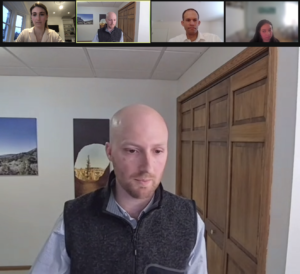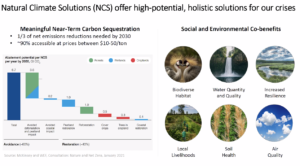

Innovation and Natural Climate Solutions to Achieve Carbon Neutrality Goals
Medium Wednesday, January 26th 2022Achieving global net zero goals by 2050 requires electrification and energy efficiency as well as enabling negative emissions. The latter occurs through carbon sequestration. While many of carbon sequestration technology has been adopted in the clean energy transition, natural climate solutions – the conservation restoration and improve land management actions that increase carbon storage – hasn’t been utilized to its full capacity.
What are the various types of natural climate solutions available? What role can these play in both the clean energy transition and achieving net neutrality goals? And what are some of the barriers to deployment of natural climate solutions? These questions were central during a Dynamo Energy Hub hosted event which brought together experts from across the natural climate solutions space.
Emily Chasan, Director of Communications at Generate Capital, set the stage for the event by explaining why natural climate mechanisms are vital to achieving net neutrality goals. Emily expressed room for growth in the sector and stated the simultaneous need for both innovation and capital being mutually beneficial as an increase in capital, demands an equal increase in innovation, and vice versa.
“Investing heavily in natural climate solutions means we’ll have more inclusive outcomes and greater opportunities for people during the energy transition.” – Emily Chasan, Director of Communications at Generate Capital.
The event transitioned into a panel discussion and each panelist stated their work in the natural climate solutions space.

Ziggy Majumdar, Senior Advisor at NYSERDA, noted how New York’s ambitious net zero goals and decarbonization efforts includes natural climate solutions. He continued that while there are existing natural climate solution programs and technology, reaching carbon neutrality goals requires the expansion of negative emissions.
Grant Canary, CEO of DroneSeed, spoke to the innovation and private sector side of natural climate solutions since his company, DroneSeed, is developing technology to regenerate and reforest some of the highest quality and reliable offsets in the natural climate solution sector – old school trees. Grant mentioned how despite trees being a fantastic sequestration mechanism, a lot of previous funding streams have historically supported methodological protocols for offsets that don’t support reforestation and therefore investment in the space is lacking.
“We need more funding streams that support reforestation. Previous methodologies and protocols for offsets have focused on easements of existing stands of trees. But to reach our net zero goals we need carbon removal in addition to locking it up.” – Grant Canary, CEO of DroneSeed
And while acquiring funding sources are a major obstacle to overcome, an increase in capital still leaves many hurdles to surmount before properly scaling reforestation – from lack of seeds, to a shortage of nursery and growth space, to a shortage of labor and the requisite capital to support such labor. Grant demonstrated implementing natural climate solutions is vastly more complicated than potentially assumed.
Dr. Nick Goeser, Technology-to-Market Special Government Employee at The Advanced Research Projects Agency-Energy (ARPA-E), provided an update on the opportunities that are coming to fruition within the natural climate solutions space. Specifically, Nick noted how ARPA-E is focused on providing investment, commercialization, and strategy support to help improve energy efficiencies from an input perspective, as ARPA-E works to invest in the solutions needed to overcome the long-term energy and technology barriers. But, as we work to overcome barriers such as the quantification of emissions, we must ensure that the processes are accessible and cost effective for farmers to incorporate into their business management strategies.
Nick brought a unique perspective to the conversation given his multidisciplinary agricultural background. He underscored two ends of meeting climate commitments and bringing down emissions spectrum — looking at the problem from an energy security standpoint to drive down emissions as well as the agricultural perspective to work across, and with, lands. Nick pointed out the wins within the agricultural sector will have a positive effect not just on climate change mitigation but on other aspects of the economy.
“The solutions within the agricultural sector will have a positive ripple effect across the board – for farmers, our economy, social and economic stability, as well as for food security. Solving small business management issues with capital and investments over time will lend itself to helping meet our national climate commitments.” – Dr. Nick Goeser, Technology-to-Market Special Government Employee at the Advanced Research Projects Agency-Energy (ARPA-E)
The conversation then turned from a federal to a state perspective as Ziggy echoed Nick’s remarks around the various types of natural climate solutions being beneficial to both climate change mitigation and ensuring a just transition.
Ziggy also commented how quantifying emissions would be tremendously beneficial as these data would help make decisions around energy efficiency and consumption, such as quantifying the embodied carbon within wood and original construction of buildings.
Nick closed out the panel by agreeing that while we need quantification, we also need standardization across how we quantify and even define assets. Given incredibly weak economic signals and competing interests, standardization will be a tremendous support for market development initiatives. Within the agricultural sector for example, standardization could overcome a barrier of price signaling and management support which would bring more individual farmers into the fold as they shift their risk portfolios over time and begin to incorporate the available technology.

One key theme throughout the panel discussion was the need for increased capital within the natural climate solutions space. Fortunately, leading impact investor Nancy Pfund, Founder & Managing Partner at DBL Partners, delivered a keynote address focused on the economic benefits of natural climate solutions.
Nancy began her remarks by noting how contrary to popular belief, investing in natural climate solutions can be lucrative while simultaneously mitigating climate change.
“Monetizing solutions for climate change can be both lucrative and have a huge impact.” – Nancy Pfund, Founder & Managing Partner at DBL Partners
And unlike other climate change mitigation tactics, natural climate solutions offer a much-needed holistic approach. The vast array of problems we collectively have around biodiversity, natural resources, and our livelihoods crisis are all interconnected requiring solutions for each of these linked problems. Nancy mentioned other benefits which come from natural climate solutions – such as a positive impact on biodiversity, higher water quality, and increased resilience such as the creation of new jobs. However, Nancy is not naive to the risks of natural climate solutions. Nancy noted risks such as permeance, lack of measurement to ensure quality, and lack of clear financial incentives. But these risks shouldn’t deter investors – if anything, these risks demonstrate the need for infusion of innovation through venture capital.

Nancy commented how the innovation cycle, private sector, and entrepreneurial side of the economy can help move natural climate solutions from volunteer efforts to programs that are essential to scale.
“There needs to be collaboration between the private sector and public sector. Only through combining the trifecta of policy, innovation, and capital will we create the change needed to meet the scale of the climate crisis.” – Nancy Pfund, Founder & Managing Partner at DBL Partners
The event then moved into an audience Q&A. A prominent theme which arose was risk of natural climate solutions being exploited as a greenwashing tactic. One solution? Transparency.
Nancy stated transparency is key since natural climate solutions are a new space without the ability to easily quantify. She added a reliance and better integration of data will also provide thorough, reliable results and prevent greenwashing.
“If we can’t quantify it, we can’t fix it.” – Nancy Pfund, Founder & Managing Partner at DBL Partners
Nancy aptly closed the event by reminding the audience for hundreds of years, societies monetized the destruction of forests – however monetizing their protection will take a completely different mindset. There must be a complete 180-degree shift in incentives and metamorphic changes in the policy landscape to favorably begin these changes.
This forum demonstrated important new frontiers in the natural climate solutions space. These emerging views are adding to the body of knowledge for us to take action, rather than risk inaction in our efforts to mitigate the climate crisis. As such, Dynamo is fostering a community of innovators to tackle the most pressing climate change and energy crisis problems.
We hope you will join us for future panels. If you would like to watch the full recording, please click here to watch.
For media relations contact
Claudia Prandoni Marketing & Communications Manager